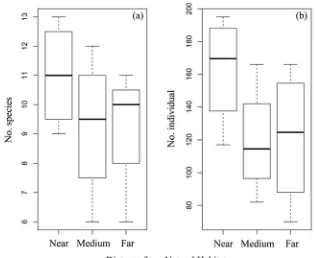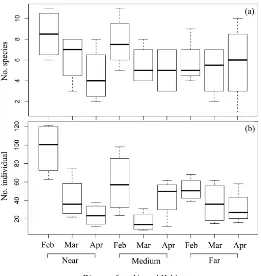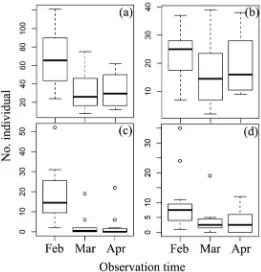EFFECT OF NATURAL HABITAT ON DIVERSITY OF HEMIPTERAN
PREDATOR IN OIL PALM PLANTATION
Akhmad Rizali1*, Toto Himawan1, Ima Fitriani1, Bambang Tri Rahardjo1, Sri Karindah1,
Retno Dyah Puspitarini1, & Bandung Sahari2
1 Deparment of Plant Pests and Diseases, Faculty of Agriculture, University of Brawijaya
Jl Veteran, Malang 65145
2 PT. Astra Agrolestari, Jakarta
Email: [email protected]
ABSTRACT
Effect of Natural Habitat on Diversity of Hemipteran Predator in Oil Palm Plantation.Utillization of natural enemies in controlling oil palm pests still encounters obstacles, in particular, how natural enemies can survive and establish in oil palm plantations. The existence of natural habitats around oil palm plantations can allegedly support the occurence of natural enemies. The objective of this study was to investigate the effect of the presence of natural habitats on diversity of hemipteran predators in oil palm plantations. Field research was conducted in oil palm plantations located in Pangkalan Bun, Central Kalimantan. The plots were oil palm plantations with different distances from natural habitat i.e. near (less than 200 m), medium (about 2 km) and far (about 5 km). Each plot was selected six trees for fogging using insecticide with active ingredient lamda cyhalothrin. Based on research result, diversity of hemipteran predator in oil palm plantion was found 19 species belong to 2 families. The most dominant hemipteran predator was Sycanus sp., Eocanthecona sp. and Reduviidae sp5. The distance of oil palm plantation from natural habitat did not affect species richness, abundance and composition as well as recolonization of hemipteran predator in oil palm plantation. Abundance of hemipteran predator tend to decrease in different observation time, except Sycanus sp. Sycanus sp was likely has ability to rapidly recolonized and their occurrence were influenced by flowering vegetation in oil palm plantation.
Keywords: Hemipteran predator, natural habitat, oil palm, diversity, Central Kalimantan
ABSTRAK
Pengaruh Keberadaan Habitat Alami terhadap Keanekaragaman Kepik Predator Hemipteran pada Perkebunan Kelapa
Sawit. Pemanfaatan musuh alami dalam mengendalikan hama kelapa sawit masih mengalami kendala khususnya bagaimana
musuh alami tersebut dapat terus berada pada perkebunan sawit. Keberadaan habitat alami disekitar perkebunan kelapa sawit disinyalir dapat mendukung keberadaan musuh alami. Penelitian ini bertujuan untuk mempelajari pengaruh keberadaan habitat alami terhadap keanekaragaman kepik predator hemipteran pada perkebunan kelapa sawit. Penelitian dilakukan di perkebunan kelapa sawit di Pangkalan Bun, Kalimantan Tengah. Plot pengamatan berupa lahan kelapa sawit dengan jarak yang berbeda dari habitat alami yaitu dekat (kurang dari 200 m), sedang (sekitar 2 km) dan jauh (sekitar 5 km). Setiap plot dilakukan pengasapan (fogging) pada enam pohon kelapa sawit menggunakan insektisida dengan bahan aktif lamda cyhalothrin.
Berdasarkan hasil penelitian, keanekaragaman kepik predator hemipteran yang diperoleh 19 spesies dari 2 famili. Kepik predator yang dominan di perkebunan kelapa sawit yaitu Sycanus sp, Eocanthecona sp, dan Reduviidae sp5. Jarak dari habitat alami tidak berpengaruh terhadap kekayaan spesies, kelimpahan, kemiripan komposisi spesies dan rekolonisasi kepik predator pada perkebunan kelapa sawit. Kelimpahan kepik predator dominan cenderung menurun pada bulan pengamatan berbeda, kecuali
Sycanus sp. Sycanus sp disinyalir mampu melakukan rekolonisasi dengan cepat dan keberadaannya dipengaruhi oleh vegetasi berbunga yang ada di lahan kelapa sawit.
Kata kunci: Kepik predator hemipteran, habitat alami, kelapa sawit, keanekaragaman, Kalimantan Tengah
Vol 18, No 1, March 2018 E-ISSN: 2461-0399
69% in the first year and increase to 96% after the second year. Oil palm pests attack starting from the seeding period until the plant produce and further attack can cause plant death (Corley & Tinker, 2003).
A control technique that commonly used to overcome pest problem is the usage of insecticides. However, the usage of insecticides has negative impact, beside economically high costs and reduces the competitiveness of oil palm products. According to Perangin-angin (2009), the cost of controlling nettle caterpillars and bagworms on oil palm plantations can reach Rp 20.67 million per hectare. In addition, the usage of insecticides also causes resistance and resurgence of insect pests, death of non-target organisms as well as environmental pollution. Therefore, it is necessary to use a control technique that are environmentally friendly and support for sustainable agriculture.
One of environmentally friendly technique to control pests is by utilizing natural enemies. Utilization of natural enemies such as predators can safely control the pest population and have no impact on the environment (Sudarmadji, 1991). In oil palm plantations, predators of nettle caterpillars and bagworms that often found are Sycanus leucomesus Stal. (Hemiptera: Reduviidae) and Eocanthecona furcellata Wolff (Hemiptera: Pentatomidae) (Susanto et al., 2012). Although often found, but the existence of those predators are still not widely utilized (Perangin-angin, 2009). To increase the population of predators, the farmers generally release predators that were mass-reared in the laboratory. However, predator population in the field still can not control the population of pests. This is related to the low ability of release predators to survive in the field and environmental factors that do not support for the predators establishment.
The existence of natural habitats or forests around agricultural land plays an important role in supporting the existence of benefit insects (Blitzer et al., 2012) including predators (Rusch et al., 2010). In the oil palm
(Tscharntke et al., 2016).
MATERIALS AND METHODS
Research Location and Observation Plot Determination. The research was conducted in oil palm plantations owned by PT. Astra Agro Lestari, located in Pangkalan Lada, Kotawaringin Barat Regency, Central Kalimantan. The observation plots were determined based on the distance of oil palm plantations from natural habitats. There were four selected natural habitats located in Agro Menara Rahmat (AMR, 537 ha, Figure 1a), west region of Gunung Sejahtera Yoli Makmur (West GSYM, 18 ha, Figure 1b), east region of Gunung Sejahtera Yoli Makmur (East GSYM, 13 ha, Figure 1c), and Gunung Sejahtera Puti Pesona (GSPP, 63 ha, Figure 1d). In each region of natural habitat, oil palm fields with different distance from natural habitat i.e. near (less than 200 m), medium (about 2 km) and far (about 5 km) were selected for observation plots (Figure 2). Area of observation plot was about 2500 m2 and six oil palm
trees were selected as sampling unit. Determination of sample trees adapted the research method by Bos et al. (2008).
In this research, we did not determine observation plots in natural habitats due to vegetation type and plant characteristics were differed compare to oil palm plantation (Figure 1). We assumed and expected that effect of natural habitat to oil palm plantation can be detected based on the distance of natural habitat to oil palm plantation.
Figure 1. Natural habitat conditions; (a) Agro Menara Rahmat, (b) West region of Gunung Sejahtera Yoli Makmur, (c) East region of Gunung Sejahtera Yoli Makmur, (d) Gunung Sejahtera Puti Pesona
diversity measurements were performed on each observation plot. Vegetation analysis was done by determining 10 random points on each observation plot with each point 1 m x 1 m size. Species richness and abundance of vegetation were calculated and taken the samples for identification. Vegetation was identified using identification book of Xu & Zhou (2017).
Insect Identification. Insect specimens were sorted into order level using the identification key of Borror et al. (1996). Identification of hemipteran predator was carried out until morphospesies of family level by distinguishing the morphological characters between specimens in the same family. In addition, if possible the specimens were also identified until genera level by using available identification key (e.g. https:// bugguide.net).
(Oksanen et al., 2015).
RESULTS AND DISCUSSION
Effect of Natural Habitat on Species Richness and Abundance of Hemipteran Predator in Oil Palm Plantation. From all observation plots, we found 19 species and 1613 individuals of hemipteran predators belong to Family Reduviidae and Pentatomidae (Appendix 1). Species richness of hemipteran predator was not affected by the distance of oil palm plantation from natural habitat (F2,9=0,845; P=0,461) (Figure 3a). Likewise, abundance of hemipteran predator did not also differ between oil palm plantations with different distance from natural habitat (F2,9=1,742; P=0,229) (Figure 3b). The presence of natural habitat has no effect on richness and abundance of hemipteran predator in oil palm
plantations. One of possible factor is the proportion of natural habitats that much smaller than the area of oil palm plantations. According to Holland et al. (2016), to support natural enemies in agricultural field, natural habitats must have sufficiently large and close enough to agricultural field. If natural habitats are too small or isolated will effect on low ecosystem services provided by natural enemies (Tscharntke et al., 2016). In addition, the same agricultural practice between oil palm
plantations with different distances from natural habitats is also possible effect on the occurrence and abundance of hemipteran predator. Previous study by Matlock & de la Cruz (2002) shown that similar agricultural practices cause similar diversity of natural enemies in agricultural habitat.
The distance of oil palm plantation from natural habitats also did not affect on recolonization of hemipteran predators. Based on observation time, the abundance of hemipteran predators tend to decrease in the second and third observation month (F2,31=9,347; P=0,0007) but no change in their species richness (F2,31=2,686; P=0,084) (Figure 4). The decline in abundance between different observation time indicated that recolonization of hemipteran predator can not occurred within a month. The dominant hemipteran predators such as Eocanthecona sp. (F2,31=11.092, P=0.0002) and Reduviidae sp5 (F2,31=3.444, P=0.044), their abundance decreased in different observation time
(Figure 5). Only Sycanus sp found its abundance did not differ between observation time (F2,31=1,283, P=0.291). Sycanus sp. might have ability to survive or recolonize faster than other hemipteran predator. Based on De Clercq (2000), Sycanus sp. is a generalist predator that can grow and develop rapidly, high adaptability and good predation ability.
Based on correlation analysis, abundance of particular hemipteran predator have relationship with abundance of flowering vegetation in oil palm plantations. Abundance of Sycanus sp. tend to increase with increasing amount of flowering vegetation in oil palm plantations (r=0.580; P=0.047). In contrast, abundance of Eocanthecona sp. (r=-0.383, P=0.218)
and Reduviidae sp5 (r=0.199, P=0.534) has no
corrrelation with flowering vegetation. Flowering vegetation within or around oil palm fields was more influential to abundance of Sycanus sp. compared with natural habitat. This finding support our hypothesis that natural habitat fails to support hemipteran predators due to oil palm plantation can provide more important resources for natural enemies than natural habitats (Tscharntke et al., 2016). According to Tjitrosoedirdjo (1984), flowering vegetation in agricultural field are important as shelter, alternative hosts and additional food sources of nectar and pollen for natural enemies including predators.
Difference of Hemipteran Predator Species Composition in Oil Palm Plantation with Different Distance from Natural Habitat. Species composition of hemipteran predator in oil palm plantation was not affected by their distance from natural habitat (ANOSIM R=-0.045, P=0.641). Oil palm plantation that located in near vs medium distance from natural habitat had 83.2% similar species, while near vs far distance was 78.9% similar species and medium vs far distance was 84.8% similar species. In addition, 13 similar species of hemipteran predator were found in oil palm plantation located in medium and far distance from natural habitat, while near and far distance was found 12 similar species. Species composition of hemipteran predator did not differ between oil palm plantations with different distances from natural habitat. This was allegedly due to similarity of vegetation types in the whole oil palm plantations. Based on vegetation analysis, we found 20 similar vegetation species in oil palm plantations between near, medium and far distance from natural habitat. According to Humprey et al. (1999), diversity of vegetation on agricultural habitat affects the composition of insects in it. Vegetation within or around oil palm field provide important contribution to the presence of hemipteran predator such as alternative habitat, shelter or resting habitat and food (prey) source.
The similarity of hemipteran predator species composition between oil palm plantations with different distance from natural habitat may also be influenced by similar habitat characteristics in each observation plot. Habitat characteristics such as food availability and habitat conditions are almost similar between observations plots and as consequence species composition of hemipteran predators were also similar. Previous research by Andrew & Hughes (2005) found that the similarity of hemipteran community can occurred due to guild similarity that related to habitat characteristics.
CONCLUSION
Diversity and species composition of hemipteran predator in oil palm plantations were not affected by distance of oil palm plantation from natural habitats. The presence of natural habitats also did not affect the recolonization of hemipteran predators in oil palm plantations. Abundance of dominant hemipteran predators showed decline in different observation times especially for Eocanthecona sp. and Reduviidae sp5, but not for Sycanus sp. Sycanus sp. was allegedly able to rapidly recolonize and its presence was influenced by flowering vegetation in oil palm plantation.
Figure 5. Abundance of dominant hemipteran predators in different observation times (month). (a) Total hemipteran
predator (F2,31=9.347, P=0.0007), (b) Sycanus sp. (F2,31=1.283, P=0.291), (c) Eocanthecona sp.
ACKNOWLEDGEMENT
This research was funded by Badan Pengelola Dana Perkebunan (BPDP) Kelapa Sawit, Ministry of Finance, the Republic of Indonesia. Many thanks to PT. Astra Agro Lestari for providing all facilities during field research. We also thanks to Radhian Ardy Prabowo, Ronny Pamuji, Ariatno, Sidik Purnomo, Santosa, and Agung Budianto who had assisted during field research.
REFERENCES
Andrew NR & Hughes L. 2005. Diversity and assemblage structure of phytophagous Hemiptera along a latitudinal gradient: predicting the potential impacts of climate change. Global Ecology and
Biogeography. 14: 249–262.
Blitzer EJ, Dormann CF, Holzschuh A, Klein A-M, Rand TA, & Tscharntke T. 2012. Spillover of functionally important organisms between managed and natural habitats. Agriculture, Ecosystems & Environment. 34: 34–43. Borror D, Triplehorn CH, & Johnson NF. 1996. An
Introduction to the Study of Insects, 6th edn. Ohio, USA: Saunders College Publishing. Bos MM, Tylianakis JM, Steffan-Dewenter I, &
Tscharntke T. 2008. The invasive yellow crazy ant and the decline of forest ant diversity in Indonesian cacao agroforests. Biological Invasions. 10:1399–1409.
Corley RHV, Tinker PB. 2003. The Oil Palm, Fourth edition. Oxford: Blackwell Science.
De Clercq P. 2000. Predaceous Stink bugs (Pentatomidae: Asopinae). In: Shaefer CW, Panizzi A (Eds.), Heteroptera of Economic
Importance. Pp. 737–786. Boca Raton, FL: CRC
Press.
Holland JM, Bianchi FJ, Entling MH, Moonen AC, Smith BM, & Jeanneret P. 2016. Structure, function and management of semi-natural habitats for conservation biological control: a review of European studies. Pest Management Science.
72: 1638–1651.
Humphrey J, Hawes C, Peace A, Ferris-Kaan R, & Jukes M. 1999. Relationships between insect diversity and habitat characteristics in plantation forests. Forest Ecology and Management. 113: 11–21.
Kalshoven LGE. 1981. The Pests of Crops in Indonesia. Jakarta: Ichtiar Baru.
Matlock RB Jr & de la Cruz R. 2002. An inventory of Parasitic Hymenoptera in banana plantations under two pesticide regimes. Agriculture, Ecosystems & Environment. 93: 147–164. Oksanen J, Blanchet FG, Kindt R, Legendre P, Minchin
PR, O’Hara RB, Simpson GL, Solymos P, Stevens MHH, & Wagner H. 2015. vegan:
Community Ecology Package. R package
version 2.2-1: http://CRAN.R-project.org/ package=vegan.
Perangin-angin BN. 2009. Ulat api (Limacodidae) dan ulat kantung (Psychidae) serta musuh alami pada pertanaman kelapa sawit (Elaeis
guineensis Jacq.) PTPN VIII, Cimulang.
Skripsi. Bogor: Institut Pertanian Bogor.
R Core Team. 2017. R: A Language and Environment for Statistical Computing. Vienna, Austria: R Foundation for Statistical Computing.
Rizali A, Clough Y, Buchori D, Hosang MLA, Bos MM, & Tscharntke T. 2013. Long-term change of ant community structure in cacao agroforestry landscapes in Indonesia. Insect Conservation and Diversity. 6: 328–338.
Rusch A, Valantin-Morison M, Sarthou J-P, & Roger-Estrade J. 2010. Biological Control of Insect Pests in Agroecosystems: Effects of Crop Management, Farming Systems, and Seminatural Habitats at the Landscape Scale: A Review. In: Donald LS (Ed.), Advances in Agronomy. pp. 219–259: Academic Press.
Simanjuntak D, Rozziansha TAP, Sudarto, Sipayung A, Chenon RD, Prasetyo AE, & Susanto A. 2011.
Informasi Organisme Pengganggu
“Setothosea asigna van Eecke”. Medan: Pusat
Penelitian Kelapa Sawit.
Sudarmadji D. 1991. Pemanfaatan Musuh Alami dalam Rangka Pengendalian Hama Tanaman Perkebunan. In: Prosiding Seminar Bioteknologi Perkebunan dan Lokakarya Biopolimer untuk Industri. Bogor: Insitut Pertanian Bogor.



